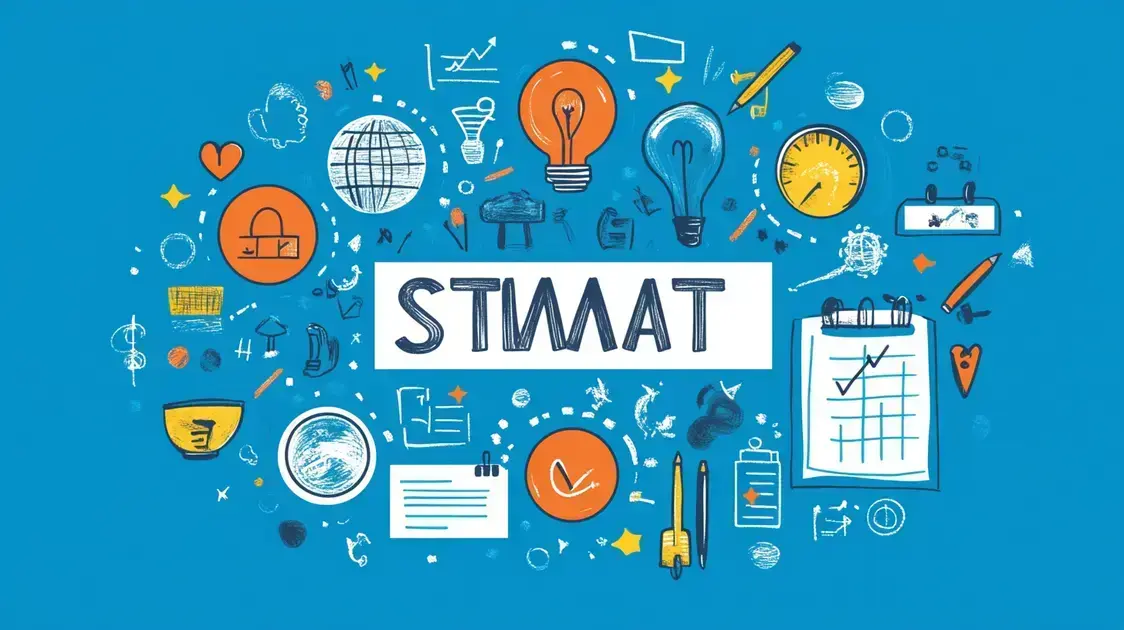Setting goals for 2025 provides a clear roadmap to achieve personal and professional success.
By following effective strategies such as SMART frameworks and leveraging tools designed for tracking progress, you’ll significantly boost your ability to stay motivated, overcome obstacles, and realize your ambitions.
This article will dive into why setting goals is crucial, practical steps to get started, and expert tips for staying on track throughout the year.
Why Setting Goals for 2025 Matters
Setting goals for 2025 is crucial because it provides a clear direction for individuals and teams to follow. Without specific goals, it’s easy to drift through the year without achieving significant progress.
Defining targets allows you to focus your energy, allocate resources effectively, and stay motivated toward achieving milestones that genuinely matter.
Moreover, setting goals ensures accountability. By having a clear vision, you can measure your progress and identify areas that require improvement.
Goals also give a sense of purpose, guiding your *day-to-day* actions and decisions in alignment with your broader aspirations.
The Psychological Benefits of Goal Setting
Research shows that goals boost both productivity and confidence. When you set and achieve goals, it releases dopamine, which enhances motivation.
A strong sense of accomplishment fuels momentum to tackle even more ambitious objectives. Furthermore, having a clear plan helps reduce stress by eliminating uncertainty, as you know what to focus on and how to direct your efforts.
It’s also worth noting how long-term goals, like those for 2025, ensure consistency. They encourage strategic planning and help you stay prepared for unforeseen challenges, giving you the ability to adapt without losing sight of the bigger picture.
Whether it’s personal or professional aspirations, establishing a detailed framework for the coming year ensures that every step taken contributes toward meaningful progress and long-term success.
Steps to Define Clear Goals
Defining clear goals is a straightforward process that ensures your efforts are targeted and achievable. The first step is to visualize what you want to achieve.
Identify specific aspirations for 2025, whether they are related to personal growth, career advancement, or financial milestones. Setting goals for 2025 requires reflecting on what matters most to you, ensuring alignment with your values and long-term vision.
Next, break down your goals into manageable and actionable steps. Large objectives can feel overwhelming, but dividing them into smaller, attainable tasks makes progress easier to track and maintain.
For instance, if your goal is to save a certain amount by 2025, plan monthly savings targets to stay on track.
Prioritize and Write Down Goals
It’s important to prioritize your goals, focusing first on high-impact ones that require immediate attention or effort.
Writing goals down is another critical step, as studies suggest people are more likely to achieve written objectives. Setting goals for 2025 with concise, actionable language ensures clarity and commitment to your intentions.
Afterward, establish realistic deadlines for each goal. Deadlines promote accountability and help allocate time effectively. However, ensure that deadlines are flexible enough to accommodate unexpected challenges without causing unnecessary stress.
Finally, track your progress regularly to evaluate your performance and adjust as needed. Consistent monitoring allows you to stay motivated while refining your strategies to meet evolving circumstances or objectives.
The Role of SMART Goals in Planning

SMART goals serve as a framework to create effective and achievable objectives. The acronym stands for Specific, Measurable, Achievable, Relevant, and Time-bound, and each component ensures the clarity and practicality of the goals you set.
Specific: A well-defined goal leaves no room for ambiguity. For example, rather than setting a vague goal like “improve fitness,” aim for something precise such as “run three miles three times a week.” Specificity provides direction and focuses your efforts on a clear target.
Measurable: Tracking progress is essential for motivation and accountability. Include measurable elements in your goals, like percentages, numbers, or milestones. For instance, if your goal is to save money, specify the exact amount you wish to save by a certain date.
Achievable: Ensure that your goals are realistic given your current resources, skills, and circumstances. Setting goals for 2025 should challenge you while remaining practical about your capabilities and time constraints. Overly ambitious goals may lead to frustration, so balance ambition with feasibility.
Relevant:
Goals should align with your broader ambitions or values. If a goal doesn’t contribute to your personal or professional growth, it’s less likely to feel meaningful or motivating. Always ask yourself how a goal fits into your long-term plans.
Time-bound: Every goal needs a deadline to create urgency and structure. Whether your timeline spans weeks, months, or years, setting a clear end date will help you stay focused and committed. Deadlines are particularly useful for breaking larger objectives into smaller, manageable tasks.
By adopting the SMART framework, Setting goals for 2025 becomes a structured and achievable process, transforming vague ambitions into actionable plans that lead to real results.
Overcoming Challenges in Goal Setting
Goal setting isn’t always straightforward, and many challenges can arise during the process. One common issue is lack of clarity. When goals are too vague or undefined, it becomes difficult to take actionable steps.
To address this, focus on specificity and write down exactly what you aim to achieve, using frameworks like SMART to guide you.
Another challenge is overcoming procrastination. It’s easy to postpone actions due to fear of failure or feeling overwhelmed. Breaking down large goals into smaller tasks and setting short-term deadlines can help build momentum and reduce anxiety.
Pairing these tasks with rewards can also motivate you to move forward consistently.
Managing Limited Resources
Access to time, money, or skills can be a barrier that hinders progress. To overcome this, start with realistic goals that align with your current resources.
For example, if finances are tight, set cost-effective strategies such as free learning tools or smaller investments to gradually work toward your objectives. Make use of online platforms and community programs to maximize access to support.
Dealing with Setbacks is another significant challenge. External factors such as unforeseen changes or personal hardships can derail plans. Preparing for flexibility is key.
Create backup plans and regularly reevaluate your goals to adapt them to new circumstances without losing sight of your overall vision. Resilience plays a critical role in moving forward.
Distractions also pose a significant challenge. Whether personal or professional, interruptions can dilute your focus.
Practicing time management techniques such as the Pomodoro method or setting boundaries during working hours can improve concentration and productivity.
By identifying specific challenges and implementing structured solutions, you are better equipped to reach your goals for 2025 while building stronger habits for long-term success.
Tools to Track Your Progress
Tracking your progress is essential for staying motivated and ensuring that you’re on the right path toward achieving your goals. Several tools can help streamline this process, offering insights and measurable data to keep you accountable.
Goal-Setting Apps: Apps like Todoist, Trello, and Asana provide structured frameworks for task management and goal tracking. These platforms allow you to organize tasks, set deadlines, and monitor your progress in real-time. With customizable boards and notifications, you’ll always stay on top of your objectives.
Digital Calendars
Tools such as Google Calendar or Microsoft Outlook are excellent for scheduling tasks and milestones. Use calendars to allocate time for specific steps within your plan, ensuring a balanced approach to both work and personal goals. The visual timeline makes it easy to track what’s coming next.
Progress Tracking Software: Apps such as Habitica and Streaks gamify the process of building habits and reaching goals by rewarding you for completing tasks consistently. These tools keep you engaged while tracking how far you’ve come.
Spreadsheets can also be a powerful option for those who prefer a customizable approach. By creating a simple table to log actions and outcomes, you can measure progress over weeks or months. Tools like Google Sheets allow collaboration if your goals involve teamwork.
Analytics and Metrics Tools: For career or business-related objectives, tools like Google Analytics or project management dashboards can provide data-driven insights. Track KPIs (Key Performance Indicators) to assess whether you’re meeting your targets in measurable terms.
No matter your preference, these tools simplify goal tracking by providing structure and reminders. Consistently review your progress using these platforms to ensure steady growth and stay focused on achieving success.
FAQ – Frequently Asked Questions About Setting Goals for 2025
Why is it important to set goals for 2025?
Setting goals provides direction, motivation, and accountability, helping you prioritize tasks and achieve personal and professional success.
What are SMART goals, and how do they help in planning?
SMART goals are Specific, Measurable, Achievable, Relevant, and Time-bound. They help create clear and actionable objectives for effective planning.
How do I overcome challenges when setting goals?
Break goals into smaller tasks, stay flexible, address obstacles proactively, and track progress using tools like apps or spreadsheets.
What tools can I use to track my goal progress?
Tools such as Trello, Google Calendar, Habitica, and Google Analytics help track milestones, time management, and measurable results effectively.
Why is flexibility important in goals?
Flexibility allows you to adapt to changes, make adjustments when needed, and stay focused even when unforeseen obstacles arise.
How do successful examples of goal achievement inspire me?
Real-world examples, like fitness transformations and career advancements, show how persistence and planning lead to impactful results.

